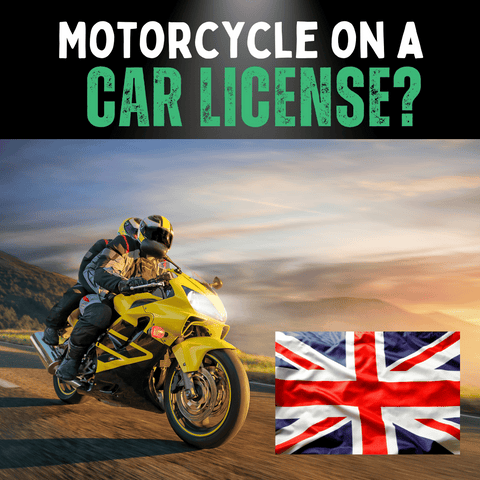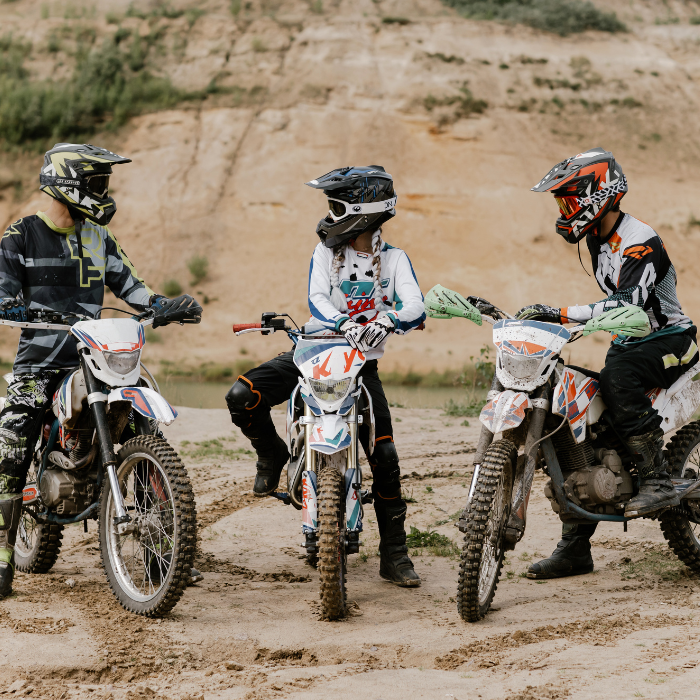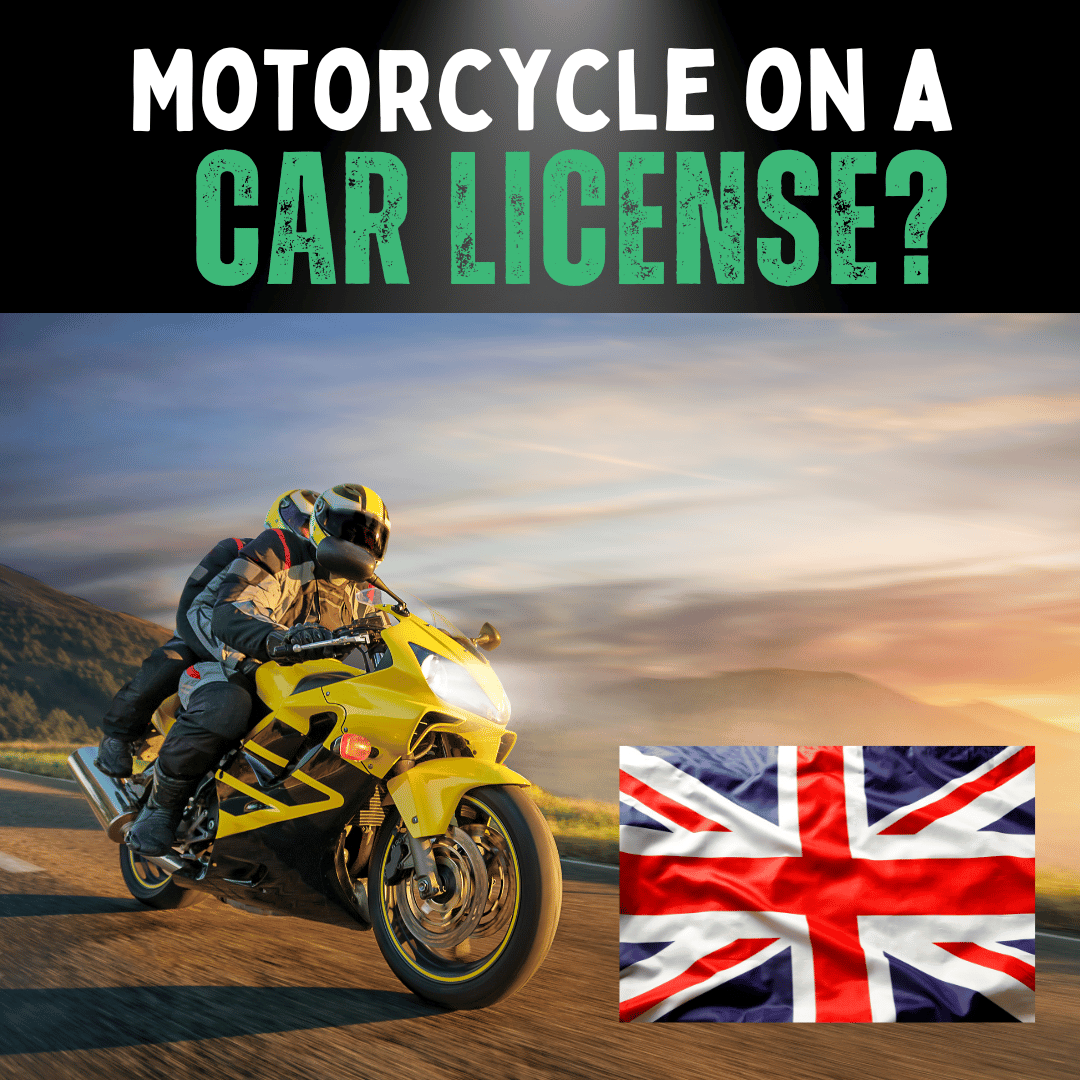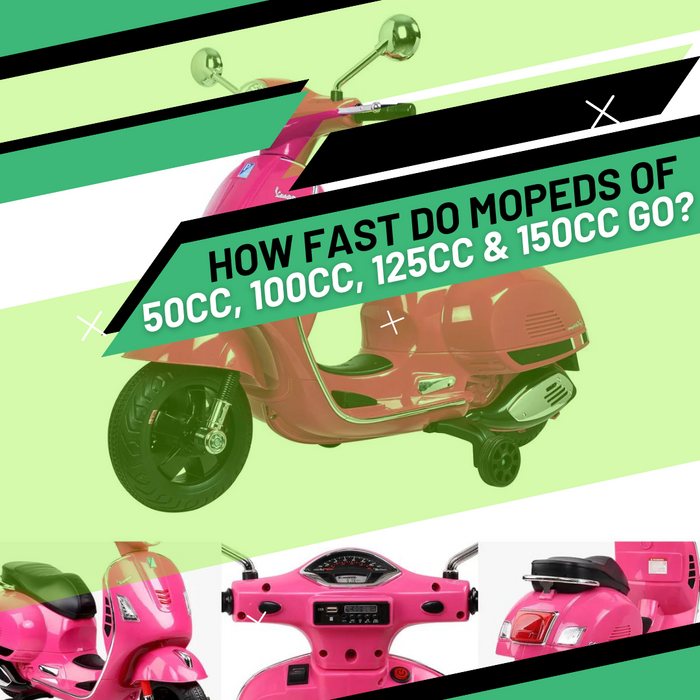
Published: 15.9.23
Updated: 14.3.25
So, you've got a full car licence and now you're contemplating adding a bit of two-wheeled thrill to your life.
Maybe it's the allure of the open road or perhaps you're just fed up with traffic.
Whatever the case, you're not alone. Many people consider transitioning from four wheels to two but get tangled in the jargon and legal requirements.
That's where this guide comes in.
We'll untangle the laws and rules for you, step by step, so you can make an informed decision and get on the road legally and safely.
Let's dive in!
What Motorbikes Can You Ride With a Car Licence? The Quick Answer
Here’s the deal with a full UK car licence:
- 50cc Moped: No L plates or moped test needed in some cases (details here).
- 125cc Bike/Scooter: Requires Compulsory Basic Training (CBT).
What Motorbike Can I Ride On A Car Licence?
In the UK, with a full car licence, you can ride a moped up to 50cc without L plates or taking the moped test in some cases. You can also ride a 125cc scooter or motorbike if you complete Compulsory Basic Training (CBT). These options offer a good balance of power and safety for road travel.
Now that we've got the quick answer out of the way, let's dig a bit deeper.
The devil is in the details, after all.
Related: Can You Buy A Motorcycle Without A License?
Basics of UK Motorcycle Licences
So you're not a biker—yet. The first step is understanding the kinds of motorcycle licences available in the UK.
The licensing rules can be a bit like alphabet soup with their various categories and subcategories.
Basically, different types of licences allow you to ride different sizes and powers of bikes, from mopeds to full-sized motorbikes.
Also, before you even think of hitting the road, you'll need a provisional licence and then you have to complete your Compulsory Basic Training (CBT).
Valuable Takeaway: Know your licence type; it's the road map to choosing the right bike and staying on the right side of the law.
Fun Fact: Did you know 50cc mopeds can hit speeds up to 28mph—perfect for zipping through town without breaking a sweat (or the law)?
Related: How Fast Do Mopeds Of 50cc, 100cc, 125cc & 150cc Go?
Understanding Road Regulations
Ignorance is not bliss when it comes to road regulations, especially for motorbikes.
Beyond the type of bike, there are various rules and conditions you need to be aware of.
Two key terms you'll often hear are engine size and power-to-weight ratio.
These two factors determine what you can ride depending on your licence.
Valuable Takeaway: Road regulations are your blueprint for safety and legality.
So study up and follow them. Would you construct a building without a blueprint?
What You Can Ride With a Car Licence
We're getting to the good stuff! As mentioned, if you have a full car licence, you can hop on a moped up to 50cc without needing L plates or a separate moped test.
But there’s a catch—you can only do this in certain situations.
On the other hand, if you fancy something a bit speedier, you could go for a 125cc scooter or motorbike.
But to do this, you must complete your CBT.
Valuable Takeaway: Think of your car licence as the appetizer. It can give you a taste of two-wheeled life, but if you want the full meal deal, CBT is a must!
Related: How Old Do You Have To Be To Ride A Dirt Bike?
Pros and Cons of Riding With a Car Licence
Pros
- Convenience: Hop on a 50cc moped with no extra tests.
- Cost-Effective: Fuel-efficient and cheap to maintain.
- Traffic Ease: Breeze through jams.
- Parking: Easy and often free spots.
- Eco-Friendly: Lower emissions than cars.
Cons
- Limited Power: No high-speed thrills here.
- Safety Risks: More exposure than a car.
- Weather: Rain and cold can dampen the fun.
- Storage: Minimal space for gear.
- Insurance: Costs can surprise new riders.
How to Choose the Right Moped or Motorbike
Ready to pick your ride? Here’s what to consider:
- Engine Size: 50cc for simplicity, 125cc for a bit more zip—match it to your commute.
- Fuel Efficiency: Look for high MPG to save cash.
- Comfort: Test ride for a comfy fit.
- Maintenance: Pick a low-upkeep model.
- Insurance: Get quotes—don’t get caught out!

Related: How To Teach Your Kid To Ride A Motorbike Safely
Common Mistakes to Avoid
Ignoring L Plate Regulations can lead to riding faults, both dangerous faults and serious faults, on your record.
Don't skip the motorcycle theory test if you intend to upgrade to a full A licence later.
Overestimating your skills can also lead to problems during a motorbike practical test.
Here are some common mistakes to steer clear of:
Be Aware of:
-
Ignoring L Plate Regulations: If you're riding a 125cc scooter or motorbike, you'll need to display L plates even if you have a full car licence. Skipping this could lead to fines or points on your licence.
-
Overestimating Your Skills: Just because you can drive a car doesn't mean you'll automatically be a skilled motorbike rider. Take it slow and consider enrolling in additional training courses for better handling and safety.
-
Forgetting Insurance: Some people wrongly assume their car insurance will cover their motorbike riding. Make sure to get a separate insurance policy for your two-wheeler.
-
Disregarding Safety Gear: Cutting corners on safety gear is never a good idea. Always wear a certified helmet and other safety equipment to reduce the risk of injury.
-
Choosing the Wrong Bike: It's tempting to opt for the flashiest or most powerful bike you're allowed to ride, but think practically. Consider your needs and limitations before making a choice.
-
Neglecting Maintenance: Smaller bikes require regular maintenance just like their larger counterparts. Regular check-ups are crucial for safe and smooth rides.
-
Ignoring Local Road Regulations: Different areas might have different rules for motorbikes and mopeds. Always check the specific road regulations in your locality to avoid legal hassles.
By avoiding these pitfalls, you'll be better prepared to enjoy your motorbike experience fully and legally. It pays to be cautious and well-informed.
Training Courses Beyond CBT

Just completed your CBT and think you're ready for the MotoGP? Hold your horses!
CBT is just the beginning.
There are more advanced courses to help you get comfortable with bigger bikes and improve your road safety.
Think of these courses as the masterclasses of motorcycling.
Valuable Takeaway: Mastery takes time and training. So why stop at the basics? The more you know, the safer—and more exciting—your rides will be.
Safety Gear and Insurance Policies
The wind in your hair sounds romantic, but it's also a one-way ticket to an accident if you're not geared up properly.
Helmets, gloves, and proper attire are non-negotiable. And while we're talking about safety, let’s not forget insurance.
Your dream bike could become a nightmare without the right policy.
Valuable Takeaway: Safety and insurance are the seat belts and airbags of motorcycling.
You wouldn't drive a car without them, so don't even think about riding a bike without proper gear and coverage.
Quick Checklist for Prospective Riders
Almost there! Before you rev up that engine, let's run through a quick checklist.
- Engine Capacity: Make sure it matches your licence type.
- Power Output: Keep it in line with your riding skills.
- Training: Completed your CBT or other necessary training?
Valuable Takeaway: Your dream bike can become a reality if you've ticked all these boxes. Consider this checklist your pre-flight checks before take-off.
Preparing for Your First Ride
Before embarking on your first journey, make sure you've completed your Compulsory Basic Training (CBT), particularly if you're planning to use the direct access route to move up to a larger bike.
Consider taking additional tests like module one and module two if you're serious about furthering your motorbike riding skills.
Having your provisional licence at hand is essential, especially if you're still in the learner's permit phase.
Checklist for Your First Ride:
- Complete Compulsory Basic Training (CBT): Also known as Compulsory Basic Training, this is a key requirement if you're planning to move beyond a moped.
- Inspect Your Bike: Make sure to check the engine's 35 kW power limit if you're on an A2 licence.
- Gather Your Documents: You’ll need your provisional driving license or a full car licence, along with your CBT certificate if applicable.
- Suit Up: Equip yourself with the necessary safety gear.
- Plan Your Route: Opt for a simpler course for your first independent ride.
- Know the Road Regulations: This is where understanding theory test pass marks could be beneficial.
- Mind Your Speed: This tip is particularly important to remember when taking your practical motorcycle test.
- Stay Alert: Motorbikes are less visible to other road users than cars. Always maintain a defensive riding position and stay alert to your surroundings.
Congratulations, you're all set for your first ride!
Just remember, the more prepared you are, the more enjoyable your riding experience will be.
Conclusion
You're now equipped with all the knowledge you need to explore the roadways of the UK on two wheels—or even three, provided they meet the right criteria for power, performance, handling, and speed.
Specifically, with a full car licence, you can ride anything up to a 50cc moped without needing L plates or a moped test.
You also have the option to go for a 125cc scooter or motorbike once you complete your Compulsory Basic Training (CBT).
These options offer the perfect balance, ensuring maximum safety for anyone looking to dip their toes into the world of motorbike riding.
For the latest and most accurate rules, it's always best to consult the Official UK Government website.
With your newfound knowledge, you're not just fulfilling legal requirements; you're unlocking the freedom and exhilaration that comes with motorbike riding.
What's holding you back?
The open road awaits—just make sure to ride responsibly!
FAQs
What Are the Age Restrictions for Riding a Motorbike with a Car Licence?
If you have a full car driving licence, you must be at least 17 years old to ride a moped or light quad bike, and 21 years old to ride any motorbike up to 125cc.
Can I Take a Passenger with Me on a Moped if I Have a Car Licence?
You can take a passenger on your moped if you're riding without an L-plate. However, ensure your vehicle is equipped to handle an additional person and that your passenger wears appropriate safety gear, including a helmet.
What Happens If I Get Caught Riding a Motorbike That's Too Powerful for My Licence?
Riding a motorbike that you're not licensed for can result in severe penalties, including fines, points on your licence, and even imprisonment in extreme cases. Always make sure your bike complies with your licence restrictions.
Is There a Way to Get a Quick Upgrade to Ride Larger Motorbikes?
The quickest way to be legally entitled to ride larger motorbikes is to go through the Direct Access Route, but this is available only to those aged 24 or older. You'll need to complete your CBT, pass the motorcycle theory test, and then pass both modules of the motorcycle practical test.







Share:
What Are Rpms On A Motorcycle?
How To Measure Rpm On Your Motorcycle